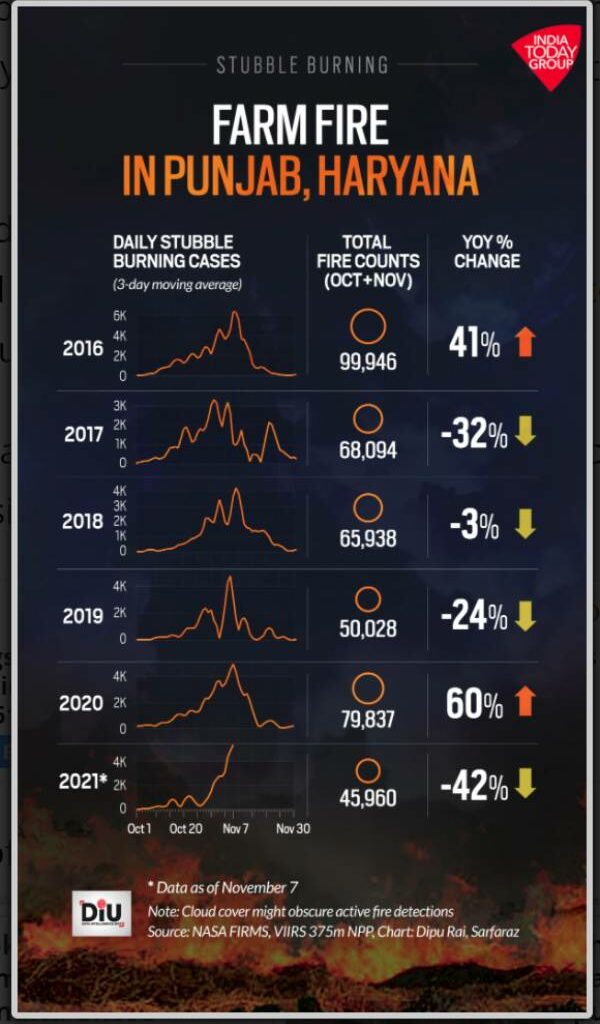News
A bird’s-eye view of farm fires in Haryana, Punjab since 2016

Farm fires remain as spread out as before in Punjab and Haryana, but with a gradual reduction in numbers over the last five years, barring 2020, data show.
Satellites detected nearly one lakh fire counts in 2016 in October and November, more than 40 per cent than 2015.
From then on, the counts came down every year till 2020. The number of farm fires last year was 20 per cent lower than 2016, but 60 per cent higher than 2019.
LESS IN NUMBERS, BUT EXTENSIVE IN AREA
The year 2017 recorded a big drop of 32 per cent in stubble burning across Haryana and Punjab, followed by 24 per cent reduction in 2019, an analysis by India Today’s Data Intelligence Unit shows.
That said, stubble-burning events are extensively spread in Haryana and Punjab despite the announcement of Rs. 2,500 an acre bonus for small and marginal farms rejecting the practice. Additionally, Punjab offers incentives to industries for buying stubble.
According to data obtained from NASA satellites, the peak has been recorded in the month of November, especially its first week, for at least the last six years.
The number of stubble burning cases in the first week of November 2016 alone stood at at 34,910, which was almost 77 per cent higher than the previous year. But the counts declined by 60 per cent in the same period of 2017.
However, the stubble-burning number changes every alternate year in the peak period of November, the DIU analysis revealed. In 2020, for instance, fire counts spurt by 60 per cent in the first week of November. In 2021 though, the cases dropped by nearly two per cent compared to the year ago.
FARM FIRES IN 2021
Considering the number of farm fires in the first week of November, the year 2021 so far ranked third with 27,941 stubble burning events after 2016 and 2020.

If the declining trend holds firm, the two states may end up with fewer cases of farm fires in October-November this year.
Punjab, Haryana, and Uttar Pradesh follow this practice to clear the fields for sowing winter crops from the last week of September to November.
There is brief window of two to three weeks between harvesting paddy and sowing the next crop.
The burning of residue depends on weather and other factors. The phenomenon in a particular period can, therefore, be recorded better through a comparison of total fire events during October and November than through day-to-day incidents.
According to reliable estimates, Punjab alone produces around 200 lakh tonnes paddy stubble. Haryana produces around 70 lakh tonnes of paddy residue every year.
-

 Tech3 weeks ago
Tech3 weeks ago12 Essential Marketing Tools Every Small Business Owner Should Try
-

 Business4 weeks ago
Business4 weeks agoSmart Strategies to Stay One Step Ahead in a Competitive Market
-

 Business4 weeks ago
Business4 weeks ago9 Low-cost Marketing Strategies and Ideas That Offer a Good Return on Investment for Small Businesses
-

 Startup2 weeks ago
Startup2 weeks agoEssential Tips for New Retail Business Owners to Succeed in a Competitive Market
-

 Tech4 weeks ago
Tech4 weeks agoHow Small Business Can Start with Marketing Automation Software
-

 Tech7 days ago
Tech7 days agoAdobe Partner with Benny Blanco to Help Small Business Branding in ‘Create Anything’ Campaign
-

 Business3 weeks ago
Business3 weeks ago7 Essential Investment Success Tips Every Investor Should Know: How to Beat the Market
-

 Tech3 weeks ago
Tech3 weeks agoGoogle’s Change to Google Local Services Ads Could Have an Impact on Millions of Small Businesses













